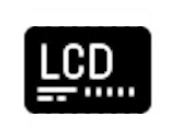
LCD_SPI_UNBUF LCD Library
This library allows you to connect a TFT LCD 16bit color display via SPI and use
it with the Espruino Graphics library in unbuffered mode. That means each g.<call>
is immediately processed, so no need to implement and call g.flip().
Support for SPI LCDs is normally provided in Espruino using a JavaScript graphics driver that is called either:
- For each pixel (slow)
- When
g.flip()is called (using a lot of memory for a buffer)
LCD_SPI_UNBUF is called for every pixel, but is written in compiled C code,
making it substantially faster. Due to its very specific nature, it is not
compiled into Espruino board firmwares, and must be compiled into a custom firmware
Sample module using LCD_SPI_UNBUF
Once you have a firmware with LCD_SPI_UNBUF:
Create a module based on this code and replace it with init commands suitable for your specific lcd board. You may be able to consult existing Graphics Drivers for this.
// ST7789V-SLU.js
/* Copyright (c) 2020 MaBecker, based on 2020 Akos Lukacs. See the file LICENSE for copying permission. */
/*
Module for the ST7789V controller with a 240x240 display
*/
var WIDTH = 240,
HEIGHT = 240,
COLSTART = 0,
ROWSTART = 0,
INVERSE = 1;
function init(spi, dc, cs, rst, callback) {
function cmd(c, d) {
dc.reset();
spi.write(c, cs);
if (d !== undefined) {
dc.set();
spi.write(d, cs);
}
}
if (rst) {
digitalPulse(rst, 0, 10);
} else {
cmd(0x01); //Software reset
}
setTimeout(function() {
//SLPOUT
cmd(0x11);
setTimeout(function() {
//MADCTL: Set Memory access control (directions), 1 arg: row addr/col addr, bottom to top refresh
cmd(0x36, 0x08);
//COLMOD: Set color mode, 1 arg, no delay: 16-bit color
cmd(0x3a, 0x05);
//PORCTRL: Porch control
cmd(0xb2, [0x0c, 0x0c, 0x00, 0x33, 0x33]);
//GCTRL: Gate control
cmd(0xb7, 0x00);
// VCOMS: VCOMS setting
cmd(0xbb, 0x3e);
//LCMCTRL: CM control
cmd(0xc0, 0xc0);
//VDVVRHEN: VDV and VRH command enable
cmd(0xc2, 0x01);
// VRHS: VRH Set
cmd(0xc3, 0x19);
// VDVS: VDV Set
cmd(0xc4, 0x20);
//VCMOFSET: VCOM Offset Set .
cmd(0xC5, 0xF);
//PWCTRL1: Power Control 1
cmd(0xD0, [0xA4, 0xA1]);
// PVGAMCTRL: Positive Voltage Gamma Control
cmd(0xe0, [0x70, 0x15, 0x20, 0x15, 0x10, 0x09, 0x48, 0x33, 0x53, 0x0B, 0x19, 0x15, 0x2a, 0x2f]);
// NVGAMCTRL: Negative Voltage Gamma Contro
cmd(0xe1, [0x70, 0x15, 0x20, 0x15, 0x10, 0x09, 0x48, 0x33, 0x53, 0x0B, 0x19, 0x15, 0x2a, 0x2f]);
if (INVERSE) {
//TFT_INVONN: Invert display, no args, no delay
cmd(0x21);
} else {
//TFT_INVOFF: Don't invert display, no args, no delay
cmd(0x20);
}
//TFT_NORON: Set Normal display on, no args, w/delay: 10 ms delay
cmd(0x13);
//TFT_DISPON: Set Main screen turn on, no args w/delay: 100 ms delay
cmd(0x29);
if (callback) callback();
}, 50);
}, 120);
}
exports.connect = function(spi, opt, callback) {
try {
HEIGHT = opt.height || HEIGHT;
WIDTH = opt.width || WIDTH;
COLSTART = opt.colstart || COLSTART;
ROWSTART = opt.rowstart || ROWSTART;
INVERSE = opt.inverse || INVERSE;
var g = lcd_spi_unbuf.connect(spi, {
dc: opt.dc,
cs: opt.cs,
height: opt.height,
width: opt.width,
colstart: opt.colstart,
rowstart: opt.rowstart
});
LCD_HEIGHT = opt.height;
LCD_WIDTH = opt.width;
init(spi, opt.dc, opt.cs, opt.rst, callback);
g.lcd_on = function(s) {
if (s) {
opt.dc.reset();
spi.write(0x29, opt.cs);
} else {
opt.dc.reset();
spi.write(0x28, opt.cs);
}
};
g.lcd_inv = function(s) {
if (s) {
//Display Inversion On
opt.dc.reset();
spi.write(0x21, opt.cs);
} else {
//Display Inversion off
opt.dc.reset();
spi.write(0x20, opt.cs);
}
};
return g;
} catch (e) {
console.log("catch:", e);
return null;
}
};
Using the module
Once you have a module, you can use it using some code like the below:
// ST7789V demo
PIN_CS = <LCD_CS_PIN>;
PIN_DC = <LCD_DC_PIN>;
PIN_MOSI = <LCD_MOSI_PIN>;
PIN_SCK = <LCD_SCK_PIN>;
PIN_BL = <LCD_BL_PIN>
demo = () => {
g.clear().setColor(1,1,1).setFontVector(40);
g.drawString("Espruino",20,50);
g.drawString("Rocks",20,95);
setTimeout(()=>{
var times = 0;
y = g.getWidth(); x = g.getHeight();
g.clear().setFont("6x8",4);
setInterval(function() {
g.setColor(Math.random(), Math.random(), Math.random());
g.fillRect(Math.random() * x, Math.random() * y, Math.random() * x, Math.random() * y);
g.setColor(0xffff).drawString(times, 0, 0, true);
times++;}, 250);
},2E3);
};
SPI1.setup({ sck: PIN_SCK, mosi: PIN_MOSI, baud: 30000000 });
PIN_BL.set();
// init the ST778V lcd and assign the SPI LCD unbufferd driver
g = require("ST7789V-SLU").connect(SPI1, {
cs: PIN_CS,
dc: PIN_DC,
width: 240,
height: 240,
colstart: 0,
rowstart: 80,
inverse: 1 }, demo);
This page is auto-generated from GitHub. If you see any mistakes or have suggestions, please let us know.